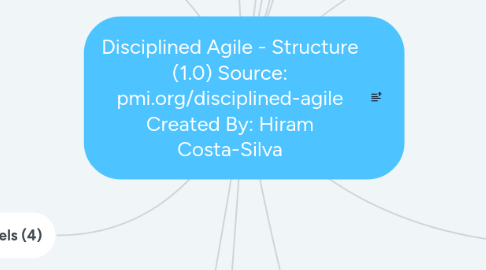
1. Ensure Production Readiness
2. Levels (4)
2.1. Disciplined Agile Enterprise (DAE)
2.2. Disciplined Agile IT (DAIT)
2.3. Disciplined Agile Devops (DADev)
2.4. Disciplined Agile Delivery (DAD)
2.5. Phases (3) and Milestones (6)
2.5.1. Inception
2.5.1.1. Stakeholder Vision
2.5.2. Construction
2.5.2.1. Proven Architecture
2.5.2.2. Continued Viability
2.5.2.3. Sufficiente Funcionality
2.5.2.3.1. Instagram: @hiramcostasilva Linkedin: linkedin.com/in/hiramcostasilva Email: hiramocs@hotmail.com Telegram DA Brazil: Disciplined Agile Linkedin DA Brazil: https://www.linkedin.com/groups/12406716/
2.5.3. Transition
2.5.3.1. Production Ready
2.5.3.2. Delighted Stakeholders
3. Lifecycles (7)
3.1. DAD
3.1.1. Exploratory
3.1.2. Agile
3.1.3. Flex
3.1.4. Program
3.1.5. Continuous Delivery: Agile
3.1.6. Continuous Delivery: Lean
3.2. DA Flex
4. Phases and Process Goals (21)
4.1. Inception
4.1.1. Form Team
4.1.2. Align with Enterprise Direction
4.1.3. Explore Scope
4.1.4. Plan the Release
4.1.5. Develop Test Strategy
4.1.6. Develop Common Vision
4.1.7. Secure Funding
4.1.8. Identify Architecture Strategy
4.2. Construction
4.2.1. Prove Architecture Early
4.2.2. Address Changing Stakeholders
4.2.3. Produce a Potentially Consumable Solution
4.2.4. Improve Quality
4.2.5. Accelerate Value Delivery
4.3. Transition
4.3.1. Deploy the Solution
4.4. Ongoing
4.4.1. Grow Team Members
4.4.2. Coordinate Activities
4.4.3. Address Risk
4.4.4. Envolve Wow
4.4.5. Leverage and Enhace Existing Infrastructure
4.4.6. Govern Delivery Team
5. Levels (4) and Process Blades (25)
5.1. DAE
5.1.1. Business Operations
5.1.2. Control
5.1.3. Finance
5.1.4. Legal
5.1.5. Marketing
5.1.6. Procurement
5.1.7. Sales
5.1.8. DAE/DAIT: Continuous Improvement
5.1.9. DAE/DAIT: Enterprise Architecture
5.1.10. DAE/DAIT: People Management
5.1.11. DAE/DAIT: Portfolio Management
5.1.12. DAE/DAIT: Product Management
5.2. DAIT
5.2.1. IT Governance
5.2.2. Reuse Engineering
5.2.3. DAE/DAIT: Continuous Improvement
5.2.4. DAE/DAIT: Enterprise Architecture
5.2.5. DAE/DAIT: People Management
5.2.6. DAE/DAIT: Portfolio Management
5.2.7. DAE/DAIT: Product Management
5.3. DADev
5.3.1. Data Management
5.3.2. IT Operations
5.3.3. Release Management
5.3.4. Security
5.3.5. Support
5.4. DAD
5.4.1. Exploratory
5.4.2. Agile
5.4.3. Lean
5.4.4. Program
5.4.5. Continuous Delivery: Agile
5.4.6. Continuous Delivery: Lean
6. Responding to feedback over following plan
7. Guidelines (8)
7.1. Validate our learnings
7.2. Apply design thinking
7.3. Attend to relationships through the value stream
7.4. Create effective environments that foster joy
7.5. Change culture by improving the system
7.6. Create semi-autonomous self-organizing teams
7.7. Adopt measures to improve outcomes
7.8. Leverage and enhance organizational assets
8. Promisses (7)
8.1. Create psychological safety and embrace diversity
8.2. Acelerate value realization
8.3. Collaborate proactively
8.4. Make all work and workflow visible
8.5. Improve predictability
8.6. Keep work loads within capacity
8.7. Improve continuosly
9. Principles (7)
9.1. Be Awesome
9.2. Context Count
9.3. Choise is good
9.4. Optimize Flow
9.5. Enterprise Awareness
10. View (4)
10.1. Mindset
10.2. People
10.3. Practices
10.4. Flow
11. Roles (10)
11.1. Primary
11.1.1. Esses papéis são comumente encontradas nas equipes do DA, independentemente do nível de escala enfrentado pela equipe. Temos: o Líder do time, Dono do Produto, Membro da equipe, Dono da Arquitetura e Stakeholders.
11.1.2. Team Lead
11.1.3. Product Owner
11.1.4. Team Member
11.1.5. Architeture Owner
11.1.6. Stakeholder
11.2. Supporting
11.2.1. Esses papéis são preenchidas, geralmente temporariamente, para resolver problemas de pontuais. Especialista, Especialista em Domínio, Especialista técnico, Testes Independentes e Integrador.
11.2.2. Specialist
11.2.3. Domain Expert
11.2.4. Technical Expert
11.2.5. Independent Test
11.2.6. Integrator
